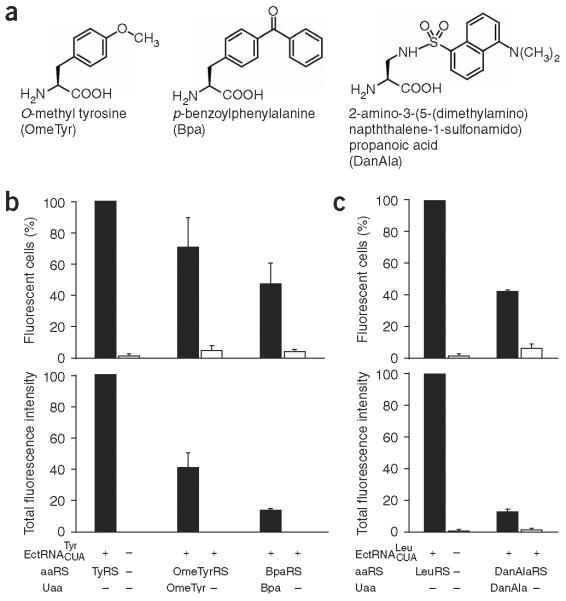Figure 2.
Unnatural-amino-acid-specific synthetases evolved in yeast are functional in mammalian cells. (a) Structures of unnatural amino acids used in this study. (b) Incorporation of OmeTyr and Bpa into GFP in the GFP-TAG HeLa cells using the and corresponding synthetases evolved from E. coli TyrRS in yeast. All data were normalized to those obtained from GFP-TAG HeLa cells transfected with the and wild-type E. coli TyrRS. Percentages (± s.e.m.) of fluorescent cells were 71 ± 19 (+ OmeTyr, n = 3); 4.8 ± 3.4 (- OmeTyr, n = 3); 47 ± 14 (+ Bpa, n = 3); and 4.2 ± 1.5 (- Bpa, n = 3). The total fluorescence intensities (± s.e.m.) were 41 ± 9.5 (+ OmeTyr, n = 3); 0.17 ± 0.02 (- OmeTyr, n = 3); 13 ± 1.4 (+ Bpa, n = 3); and 0.11 ± 0.06 (- Bpa, n = 3). (c) Incorporation of DanAla into GFP in the GFP-TAG HeLa cells using the and a DanAla-specific synthetase evolved from E. coli LeuRS. Data were normalized as in b. Percentages (± s.e.m) of fluorescent cells were 42 ± 1.3 (+ DanAla, n = 3) and 5.9 ± 2.6 (- DanAla, n = 3). The total fluorescence intensities (± s.e.m.) were 13 ± 2.1 (+ DanAla, n = 3) and 1.4 ± 1.0 (- DanAla, n = 3).

